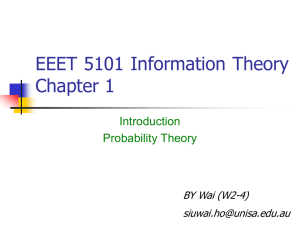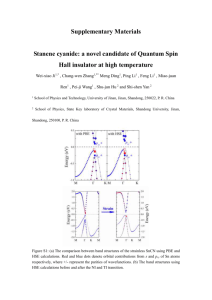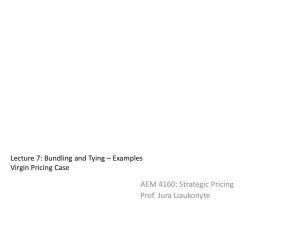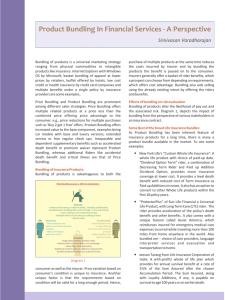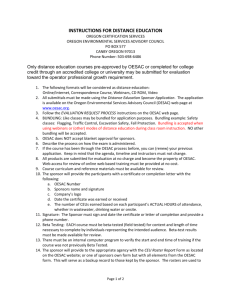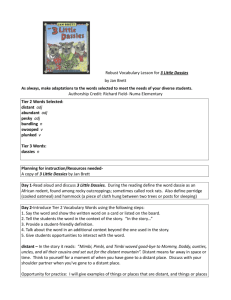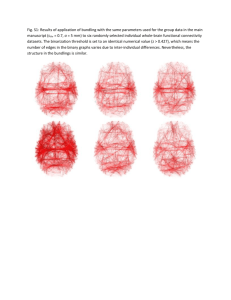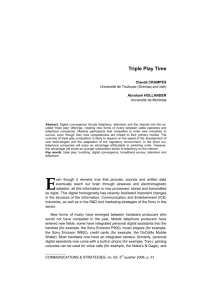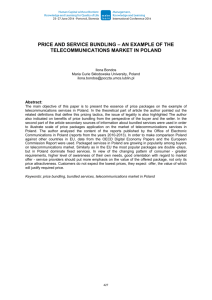pure conditional
advertisement
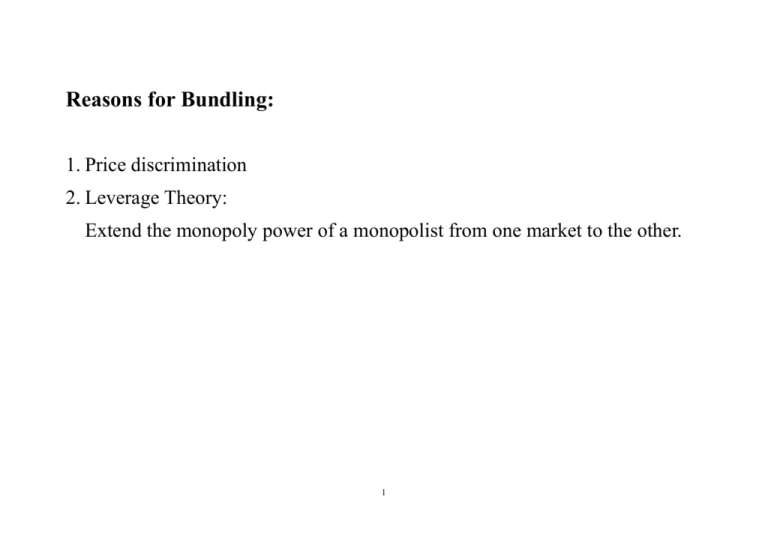
Reasons for Bundling: 1. Price discrimination 2. Leverage Theory: Extend the monopoly power of a monopolist from one market to the other. 1 McAfee, McMillan and Whinston (1989). Conditions under which bundling is an optimal strategy. Some preliminaries: The rationale: To exploit the difference of consumers’ willingness to pay. B 100 1(25, 75) 2(50, 50) 3(75, 25) A 100 2 By charging a bundled price of $100, the firm can exploit all consumer surplus of all consumers. Question: Under what condition is bundling always better than unbundling? Model: One monopolist, two goods (1 & 2), Good i is produced with constant MC, Ci. A consumer buys good i if its price Pi, is lower than the utility it brings, vi. Distribution of consumers’ tastes: F V1 , V2 . f V1 , V2 : density. g i Vi / V j : conditional density. Gi and H i are corresponding distribution function. 3 pure bundling: Offer bundled good only. mixed bundling: The consumers are allowed to buy both bundled good and separately. mixed bundling dominates pure bundling. This is because for any pure bundling with price PB , we can always create a mixed bundling with ( PB , P1 PB C2 , P2 PB C1 ), which makes at least equal profit. 4 * * Proposition 1. Let ( P1 , P2 ) be the optimal nonbundling prices. Mixed bundling dominates unbundled sales if 1 G P | s g P | s P P * 1 0 2 * 2 2 * 2 * 2 c2 h1 s ds P1* c1 1 G2 P2* | P1* h1 P1* 0 P1* P2* v1 v2 * * Create a bundle with price P1 P2 * Raise price of good 2 to be P2 Keep price of good 1 unchanged 5 Corollary 1. If v1 and v2 are independently distributed, then bundling dominates unbundled sales. Proof of Corollary 1. For the case of independently distributed reservation values, condition (1) reduces to (note that i=1,2): hi P g i P | s for all (P, s) and * * * * * * * (2) H1 P1 1 H 2 P2 h2 P2 P2 c2 P1 c1 h1 P1 1 H 2 P2 0. But, if P2* is the optimal unbundled price for good 2, then the first term in (2) is equal to zero, so that (1) reduces to * * * (3) P1 c1 h1 P1 1 H 2 P2 0. 6 Now, by the assumptions of no atoms and existence of a positive measure of * * valuations above cost, P1 c1 1 H 2 P2 0. Also, under our continuity assumption it must be that h1 P1* 0 (again, from the nonbundling first-order condition). Thus, condition (3) holds, and a local gain from bundling is possible. Q.E.D 7 Chen (1997): Considers the incentive to bundle for two firms which are duopolists in one mkt, and there is perfect competition in the other. Two firms: A, B Two goods: X, Y MC for X is c, and cY for Y A continuum of consumers with mass 1. Consumers are identical, whose valuation for X is r. Demands for X and Y are independent. Only one X is needed. 8 Valuation for Y is v, which is stochastic with density g(v). G(v) is corresponding distribution function. v v, v , v cY v . Two-stage game: 1st stage: Firms decide whether to (i) sell X only; or (ii) sell X & Y as bundle (XY); or (iii) sell both X and XY at the same time. 9 2nd stage: The firm decides the prices for its products the firms offer. Thus the 2nd stage is Bertrand competition. There are 4 possible subgame in 2nd stage: (X, X), (X, XY), (XY, X), and (XY, XY). First exclude the possibility of mixed bundling. (i.e., (iii) above). This will be justified. 10 Solution: (pure strategies only) Case one (X, X): Both offer PX c and make zero profit. Case two (XY, XY): Both offer PXY c cY , and make zero profit. Case three (XY, X or X, XY): (1) At any equilibrium, PX c , PXY c cY . That is, both firms make positive profits. (2) In equilibrium, one firm offers X, and the other XY. 11 Reason for (1): For a consumer with valuation v for Y, whether he will buy X or XY depends on the relative size of r PX and utility for buying Y r v PXY utility for buying XY The # of buyers for X is thus q X PXY , PX G PXY PX ; if PXY PX cY , PX r 1; if PXY PX cY , PX r 0 ; if PX r 12 Demand for XY is thus 1 q X ; if Px r. Profit for firms selling X and XY are X PX c q X PX , PXY XY PXY c cY q XY PX , PXY 13 * * P P Suppose X and XY are equilibrium prices. Then * * X PX* , PXY X c , PXY * * P c P (obviously, X and XY c cY ) * G PXY c cY 0 if is small enough. PX* c, *X 0 . 14 Given that PX c , we can set 0 small enough so that c cY PX* cY , and under that price the # of buyers for XY is at least * c cY and *XY 0 . 1 GcY 0 . That means it must be that PXY * Q.E.D (2 ) follows immediately from (1). * Note that this argument depends critically on the assumption of Bertrand competition. 15 (3) FOC: P x c 0, g Pxy Px G Pxy PX Pxy c c y 1G Pxy P g Pxy Px 0. 16 * * A unique pair Px , Pxy solves FOC if gv d Gv 0, dv d ( and gv ) 1G v 0. dv * * Px Pxy c y . There is transfer of surplus form consumers to firms in the X market. However, dead-weight loss occurs when consumers with v c y buy the bundle XY. 17 When bundling is allowed, producers of X are better off, and consumers worse off social welfare reduces. Even if the Y market is competitive, firms in X market can still benefit from bundling because it provides a useful way to differentiate X and thus gain market power. 18 Example: g v 1, 0 v 1, c 2 / 3 , 3 5 5 / 2 c y 1. Then Px* c 1 c y / 3 and Pxy* c 2 1 c y / 3 . *x [ 1 c y / 3 ]2 and *xy [ 2 c y / 3 ]2 . Consumers with 1 c y / 3 v c y buy XY and consume Y. There is inefficiency. When mixed bundling is allowed: When both firms offer (X, XY), both earn zero profits. When one firm offers XY and the other (X, XY), the former makes zero * * profit and the latter * , with 0 X . 19 Mixed bundling is thus a weakly dominated strategy. Sharp contrast to McAfee et. al.. Intuition: Product differentiation role is undermined if mixed bundling is offered. 20 (4) Firm selling X earns higher profit than firm selling XY. The game is somewhat like a battle- of-sex game, in that every firm would like the opponent to bundle in order to soften competition. But will itself bundle if it expects the other firm not to. A B A B 3, 3 2, 1 1, 2 3, 3 21 (4) If bundling is allowed, producer of X is better off, and consumers worse off. Social welfare is reduced. XY Y CY * PXY PX* CY=PY X X c=PX C PX* (5) Contrary to conventional wisdom, mixed bundling is dominated by pure bundling. 22 Literature review: Schmalensee: monopoly competitive bundling is useless. Whinston: monopoly + oligopoly; bundling useful. Chen: oligopoly+ competitive; bundling useful. Topics to pursue: (1) Oligopoly + oligopoly prisoners’ dilemma? 23 (2) Bundling goods are usually complements e.g. Explorer + window cable + program printer + cartridge phone + internet (i) What are the effects when we make special assumptions on characteristic of good? (ii) In particular Perfect complement One good requires the other to use, but not the other way round. 24

